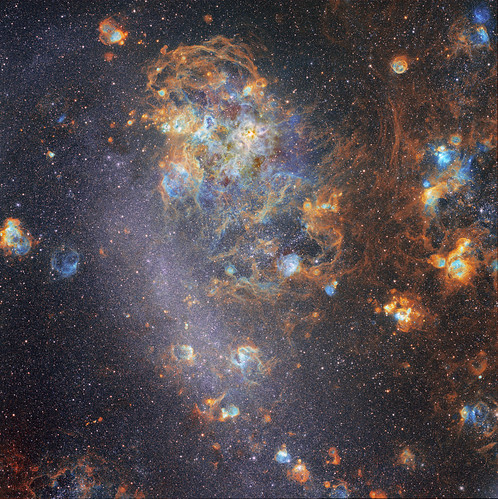Roland wrote:Question: Are the clouds of Magellan galaxy's or are they galaxy fragments? I don't see any evidence that there is a galaxy core or black hole that normal galaxy's seem to show. Therefore to me they seem more like galaxy fragments, as in the debris from a galaxy merge.
The Large Magellanic Cloud doesn't have a core. Not all galaxies do. A galaxy is a collection of baryonic matter (stars, gas, planets etc) and non-baryonic matter (dark matter) that isn't a part of a larger galaxy, and that is held together by self-gravity.
The Clouds of Magellan.
Photo: John Gleason.
The Large Magellanic Cloud.
Photo: Eckhard Slawik.
The clouds (make that nebulas) of the Large Magellanic Cloud are just parts of the galaxy as a whole. Therefore, they are not "galaxy fragments".
However, the APOD we are discussing, seen at left, doesn't show us the large Magellanic Cloud as a whole. To see what the entire galaxy looks like, including the clouds seen in the APOD, check out the picture at right. Look at the complex of pink clouds near the center of Eckhard Slawik's picture. These pink clouds are the magnificent Tarantula nebula and associated nebulosities. They are what you see in the APOD. But the APOD shows them in so called "representative colors", so they don't look pink there. Myself, I prefer RGB images, like the picture at right.
The Phoenix Dwarf Galaxy.
Copyright: CHART32, processing: Johannes Schedler
NGC 4449. Photo: Rob Gendler.
Consider the two galaxies at left and right. At left is the Phoenix Dwarf Galaxy, a very puny, lightweight collection of stars, gas and dark matter. It doesn't have an obvious core at all. But it isn't a part of another galaxy, so it is a galaxy in its own right.
At right is NGC 4449, a galaxy that is similar to the Large Magellanic Cloud, except that it contains even more bright, large emission nebulas than the LMC. NGC 4449 is churning out stars at a prodigious rate. But just as is the case with the LMC, all the bright nebulas of NGC 4449 are just parts of the galaxy as a whole.
Ann
 Shell Game in the LMC
Shell Game in the LMC

